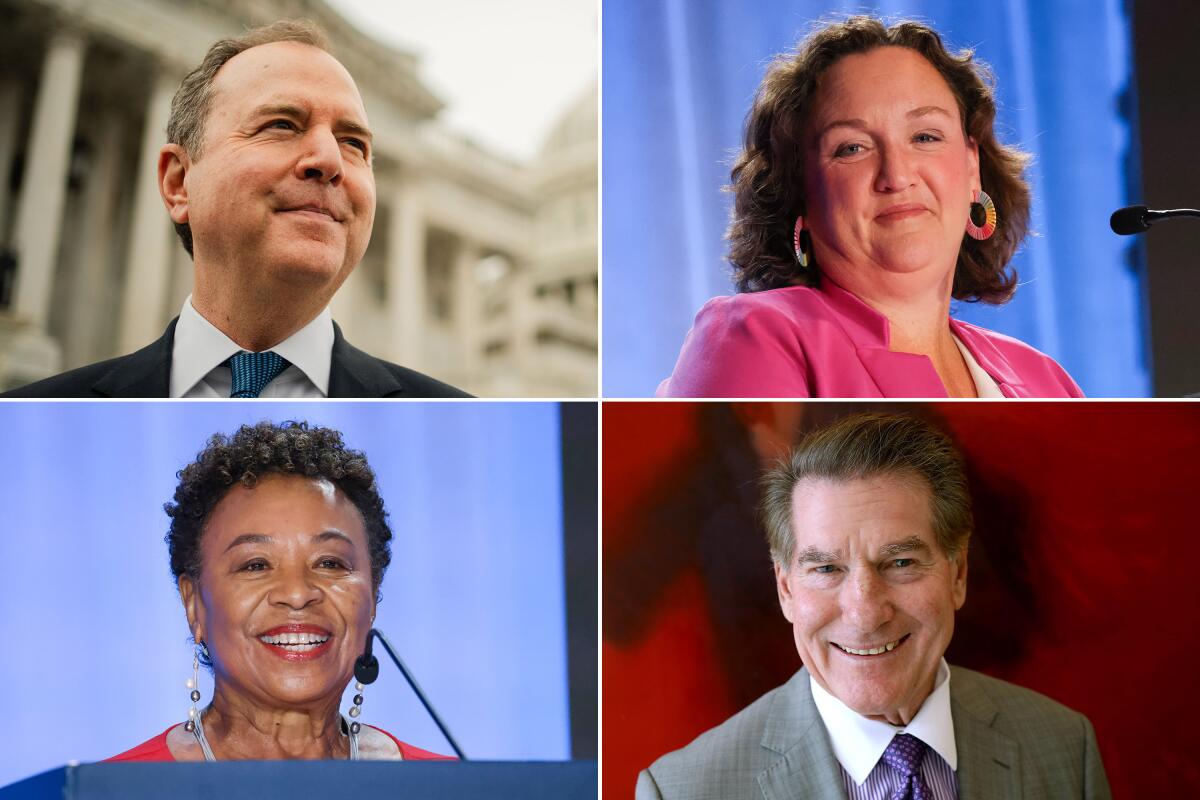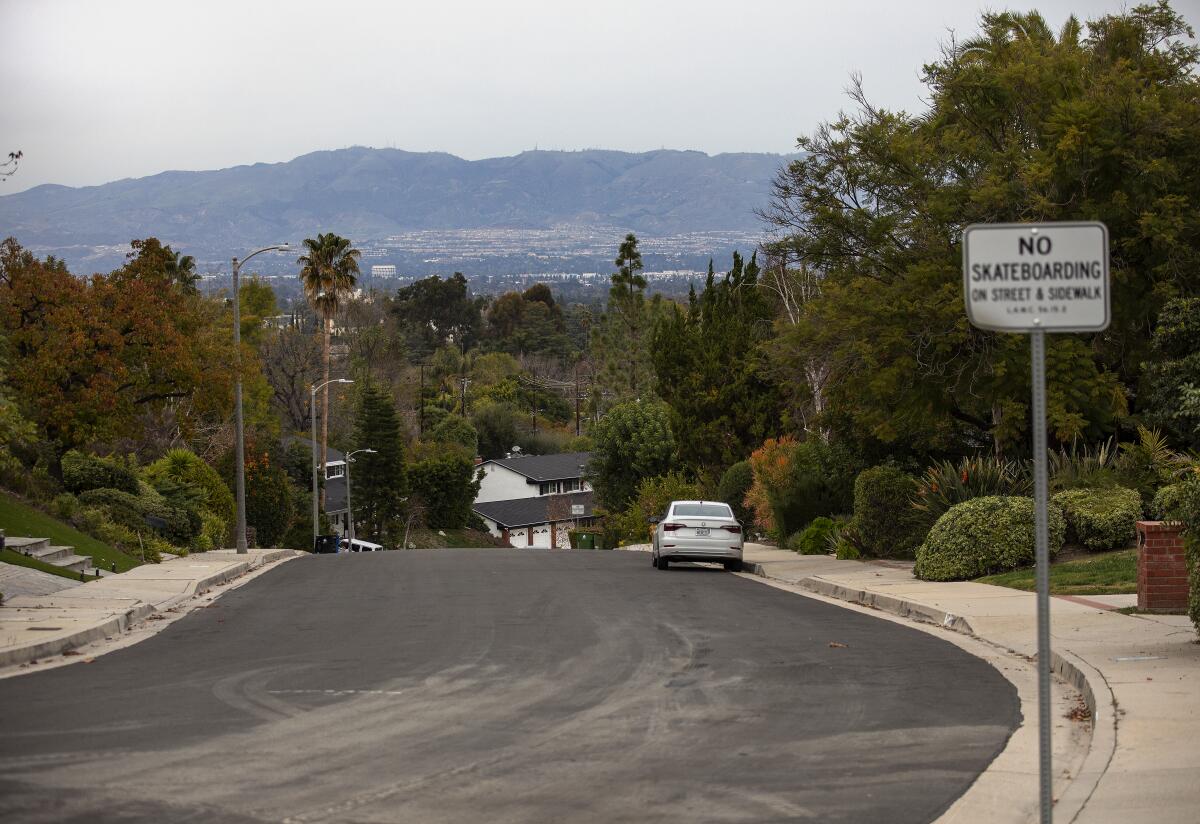Can AI help make our roads less congested and deadly? Don’t bet on it, researchers say

Good morning. It’s Friday, Jan. 12. Here’s what you need to know to start your day.
- Can AI help make our roads less congested and deadly? Don’t bet on it, researchers say
- Schiff leads Porter, Garvey and Lee as the Senate primary nears
- How to spend the night in a lighthouse on a tiny California island
- And here’s today’s e-newspaper
Sign up for Essential California
The most important California stories and recommendations in your inbox every morning.
You may occasionally receive promotional content from the Los Angeles Times.
Can AI help our roads? Don’t bet on it, researchers say
Are you tired of sitting in traffic, thinking, “There’s gotta be a better way”?
Well, you’re in luck, California! The state’s transportation agency wants to put AI to use to help make our commutes less of a soul-wrenching nightmare.
Caltrans is asking tech companies to pitch generative AI tools that could help the state reduce congestion and make roads safer.
“Generative AI tools such as ChatGPT can quickly produce text, images and other content, but the technology can also help workers brainstorm ideas,” Times reporter Queenie Wong wrote this week. “The request shows how California is trying to tap into AI to improve government services at a time when lawmakers seek to safeguard against the technology’s potential risks.”
Anyone else have déjà vu? For more than a century now, government leaders and an array of industries have been pitching us on the cure for our traffic troubles. More lanes! More transit! Carpool and express lanes! Flying Ubers! Autonomous vehicles! To the tunnels!
Spoiler: Nothing has worked (short of a historic global pandemic) to unclog our roads.
California remains one of the most congested and deadliest states to walk, bike and drive (and we have the terrible air to prove it).
So what would AI bring to the table? The details from Caltrans are vague, in large part because the agency isn’t sure what the tech could ultimately do.
Rick Brewer, spokesperson for Caltrans in Sacramento, said the technology could be used to analyze an immense amount of incoming traffic data much faster than is humanly possible and present traffic engineers with potential solutions related to signal timing and lane usage. He admitted he was “spitballing,” adding that the agency sees potential in AI scouring data to identify previous hotspots for traffic collisions, along with future hazards that engineers could use to add safety improvements more quickly.
“We think there’s a lot of potential there,” Brewer said. “And I don’t think any of us are even totally aware of what that potential might be.”
Shiny new tech, same ol’ problems
Michael Manville, UCLA professor and chair of the Department of Urban Planning at its Luskin School of Public Affairs, isn’t so optimistic about that potential, given decades of evidence about what does and doesn’t work.
It comes down to the simple economic principle of supply and demand. We have limited space to drive and we drive a lot. And widening roads just creates more space to drive, which attracts more drivers long-term, and we’re back to the slow slogs we know and hate.
“You’re telling me we need advanced AI to figure out that it doesn’t do much good to widen the f—ing road?” he said. “We’ve known this since like 1920.”
Manville argues that a lack of data-backed solutions isn’t the problem, but rather a lack of political courage to put existing solutions, such as congestion pricing, into play. That model has been implemented in several global cities for decades, and New York is poised to become the first U.S. city to implement it. L.A. County officials are just beginning to explore it.
“California has dangerous roads [and] bad traffic congestion in comparison to plenty of other places in the United States — and plenty of other places in the world,” he told me. “That’s not because those other places have gotten to Skynet first. They just made some hard decisions that we won’t make.”
Manville worries AI could become the latest thing that government officials hold up as a shield from “political trade-offs.”
“If you want to make cities safer for pedestrians, if you want to lower speeds, if you want to deal with congestion in a meaningful way, technology is not going to rescue you from difficult political decisions,” he said.
Caltrans’ Brewer said the agency doesn’t view AI as a “smokescreen” to hide behind in lieu of bolder policy changes — rather, officials hope the technology will help support such changes by surfacing data that justify upgrades and solutions.
“Twelve people every day die on state highways and interstates,” he said. “Caltrans is an organization that seriously wants to create a safer highway system. I almost feel like we’d be derelict in our duty if we didn’t use what we consider to be the best tools at our disposal to help us get to that ultimate end goal of eliminating deaths and serious injuries on the state highways.”
Are we too obsessed with fixing traffic?
If we haven’t made driving less of a hellscape in 100 years, why should we expect AI to finally get it right?
Susan Handy, a distinguished professor at UC Davis and director of the National Center for Sustainable Transportation, doesn’t think we should. She argues the state’s century-long “congestion obsession” has actually made things worse, mostly because the state’s solution has historically been to just add more lanes. Caltrans was, after all, established to build highways.
“If you have a hammer, every problem looks like a nail,” she said.
Handy argues that reducing congestion shouldn’t be the goal — but providing alternatives to congestion should be.
That would require better land use planning in tandem with transportation planning, which Handy said is mostly separated now. Planning decisions that promote density would shorten the distances people need to travel. That’s the complex key to truly improving commutes, she said.
“We actually know how to solve our problems,” she said. “The reason we’re not doing it is largely political will and leadership not being willing to go out on a limb to push the policies we know will make the most difference.”
Today’s top stories

Elections 2024
- Rep. Katie Porter and former Dodgers star Steve Garvey are in a tight contest to see who will join Rep. Adam B. Schiff in a runoff for the U.S. Senate this fall.
- Florida Gov. Ron DeSantis and former U.N. Ambassador Nikki Haley called each other liars and attacked each other’s leadership abilities in their first one-on-one debate.
Climate and environment
- Avalanches are rarely a danger at U.S. ski resorts. The Palisades Tahoe slide was a deadly exception.
- Ventura declares a state of emergency as wind and surf continue to batter the Southern California coast.
- As California transitions to electric vehicles, the loss of gas tax revenue may hurt roads.
Hunter Biden’s tax charges
- Hunter Biden pleads not guilty in L.A. to tax charges.
- Who would lend millions to Hunter Biden? Meet the Hollywood lawyer who has.
Politics
- L.A. Times poll: Younger, older Californians take starkly different views of Israel-Hamas war.
- Newsom suggests ways to crack down on property crime without dismantling Proposition 47.
Business
- Why stubborn inflation is especially painful for California consumers.
- Twitch is laying off 500 workers. Its CEO is upset the news leaked early.
More big stories
- Cuong Tran’s iPhone was sucked out of the side of Alaska Flight 1282 when a door plug blew out. He got it back — but not his sock or shoe.
- Four L.A. County sheriff’s deputies were fired and others were disciplined after an altercation involving members of an alleged gang known as the Industry Indians.
- The 9th Circuit upheld limits on San Francisco’s clearing of homeless encampments.
- These L.A. residents got $1,000 a month. What happened after the cash stopped?
- Were California’s grizzlies really ravenous meat eaters? Not so much, a new report shows.
Get unlimited access to the Los Angeles Times. Subscribe here.
Commentary and opinions
- George Skelton: Newsom’s budget plan reflects his rosy view of the economy.
- Sammy Roth: Yes, wind turbines kill birds. But fracking is much worse.
- Opinion: Three winter storms in the U.S. in a week? They all have a single cause.
- Michael Hiltzik: How a legal loophole allows antiabortion prosecutors to obtain women’s secret health data.
- Opinion: The musical gift Los Angeles offers public school kids.
- Jackie Calmes: When immigrants are demonized, the U.S. betrays its ideals — and economic reality.
Today’s great reads
Created in California: How Barry’s turned grueling military workouts into a sexy lifestyle. Founded in West Hollywood 25 years ago, Barry’s helped launch the era of the modern boutique fitness studio. Its glamorous devotees wouldn’t sweat anywhere else.
Other great reads
- Are you a Stanley or Hydro Flask person? Here’s what your water bottle says about you.
- These performers are challenging traditional gender roles in Latin dance.
- 2024 will test us. What can we learn from Strength, tarot’s card of the year?
- Jo Koy grades himself on the Golden Globes as he prepares for Kia Forum shows.
- A rising star at celebrity trials like O.J. Simpson’s. Then a quiet, mysterious death.
How can we make this newsletter more useful? Send comments to essentialcalifornia@latimes.com.
For your downtime

Going out
- 🌊 How to spend the night in a lighthouse on a tiny California island.
- 🎥 In the tiresome musical remake of “Mean Girls,” now in theaters, the limit very much does exist.
- 🖼️ Take an artistic voyage from Troy to Bahia with these shows inspired by history.
Staying in
- 📺 Jennifer Lopez releases “Can’t Get Enough” video poking fun at past marriages.
- 📕 How one acclaimed poet’s long, private letter became a short, stunning novel.
- 🧑🍳 Here’s a recipe for Mele Fritte (apple fritters with vanilla sugar).
- ✏️ Get our free daily crossword puzzle, sudoku, word search and arcade games.
And finally ... a great photo
Show us your favorite place in California! Send us photos you have taken of spots in California that are special — natural or human-made — and tell us why they’re important to you.

Today’s great photo is from Times photographer Mel Melcon on Hermano Drive in Tarzana, the only cul-de-sac in L.A. where an ordinance specifically outlaws skateboarding.
Have a great day, from the Essential California team
Ryan Fonseca, reporter
Elvia Limón, multiplatform editor
Kevinisha Walker, multiplatform editor
Laura Blasey, assistant editor
Check our top stories, topics and the latest articles on latimes.com.
Sign up for Essential California
The most important California stories and recommendations in your inbox every morning.
You may occasionally receive promotional content from the Los Angeles Times.




